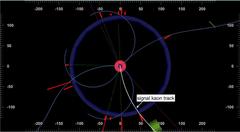Rare and exciting: DESY scientists look for events like these in the Belle II detector. Image: Belle II / DESY
Researchers from DESY working on the Belle II experiment in Japan have published the fourth Belle II paper since the beginning of data taking. They study the decay of B mesons that are produced in collisions at Belle II into kaons and neutrinos – a rare but highly interesting decay. If nature does not behave the way theory predicts, scientists could see it in this process. So far, they have found no deviation from predictions –“but we are only at the beginning”, says DESY researcher Sasha Glazov.
A few weeks ago, a result from the LHCb experiment at CERN in Geneva caused a lot of excitement among particle physicists around the world. There were hints that the underlying theory of particle physics, the so-called Standard Model, could not explain the behavior of a set of particles observed in LHCb. It’s too early to say if it’s a statistical glitch or a proper discovery, but if it turns out to be the latter this would be a sensation. It could mean that there must be more particles and different interactions than predicted and observed so far and that the theory needs to be rewritten or at least extended.
The Belle II detector at the Japanese research centre KEK complements LHCb in many ways. The effect observed by LHCb should thus logically also show up in the data collected by Belle II. The DESY team consisting of Sasha Glazov, two postdocs (Simon Kurz and Slavomira Stefkova) and two PhD students (Cyrille Praz and Filippo Dattola) selected only those events that had produced a B meson (a particle consisting of one up and one bottom quark) which then decayed into a kaon (a particle containing one up and one strange quark) and two neutrinos. The neutrinos are invisible to the detector, so the hunt was on for events showing only the one particle, the kaon . “That is very simple and very difficult at the same time,” says Glazov – simple because events are easy to identify, and difficult because they are very rare and difficult to detect.
In some 100 million events the researchers identified around 20 event candidates that might be attributed to this decay mode. These look like those predicted by the Standard Model, i.e. so far they do not confirm the hints at unexpected results from LHCb. However, that can change when Belle II collects more data and thus more statistics. Its associated collider SuperKEKB has already broken the record for most collisions produced per second, so many collisions are expected over the next years.
The data containing the kaon events were collected almost exclusively during the pandemic, making it a very special data set. Normally the international particle physics community involved in Belle II would have come to Japan to participate in shifts during data taking; a task that was now handled mostly by local researchers. However, this was only possible by moving a large fraction of the round-the-clock detector operation of Belle II to remote sites all around the world.
The paper will also be a milestone in the physics history of Belle II because it is the first one based on data collected with the complete detector. Previous analyses had used collisions collected by Belle II in a pre-stage, in particular without the new pixel vertex detector, for whose construction, commissioning and data analysis DESY has leading responsibility. This detector forms the heart of Belle II’s precision measurements and played an important role in selecting the signal events.
A third novelty that had a big influence on this paper and is likely to benefit the study of Belle II data in the future is a new approach to data analysis using machine learning methods. The “usual” way for this specific search would have been to search for the energy that is *not* there (because the two neutrinos from the decay took it with them, so to say) and then check whether a kaon was involved in the beginning to fully reconstruct the decay of the B meson. This new technique searches for the kaon directly – a rather logical approach, but impossible without machine learning because of the amount of information that needs to be computed. “Thanks to the improved method developed by the DESY team, it should be possible to confirm or rule out the new physics contributions with a smaller data sample than originally anticipated,” says Glazov. Any hints at deviations from prediction would thus be easier to identify.








